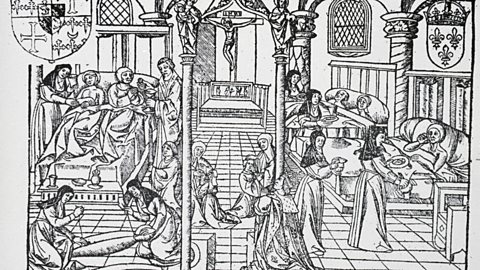The role of the Church and monasteries
The Church played a major role in patient care in the Middle Ages. The Church taught that it was part of a Christian’s religious duty to care for the sick and it was the Church which provided hospital care. It also funded the universities, where doctors trained.

There were about 1,200 places in medieval England and Wales describing themselves as 'hospitals'. Almost all of them were run by the Church. Many were monastery infirmaries, eg Tintern, Valle Crucis and Strata Florida, or other religious houses, eg the Franciscan friaries in Cardiff and Bangor.
However, these medieval hospitals were very different from modern hospitals.
- They were run by monks or nuns and a patient’s spiritual welfare was as important as his medical needs.
- The monks had only basic medical knowledge (though they were probably the best qualified to do the work).
- Certain people were excluded, eg those with contagious diseases, leperA person suffering from leprosy, a bacterial infection that causes serious damage to the nerves and skin., people with disabilities, and people with mental health problems. It was believed at the time that they would infect the others.
Medieval hospitals
This chart shows only about 10 percent of medieval hospitals cared for the sick in the way that modern hospitals do. They were only called hospitals because they provided hospitality, ie a place to rest and recuperate. Most hospitals were actually almshouseHousing provided by charities for people (usually the elderly) who can no longer provide for themselves. for the elderly and infirm, which provided basic nursing, but no medical treatment. Other hospitals, eg Ysbyty Ifan in Clwyd were situated on important pilgrimage routes and were set up as hostels for pilgrims.
Bimaristans
Medical care by physicians or doctors seems to have been rare in medieval hospitals. There are a few references relating to such provision at London hospitals in the late Middles Ages. In 1524, for example, Henry VII’s Savoy Hospital (founded by the king in 1505) was expected to have a doctor and surgeon.
In the Middle Ages the Islamic world was far ahead in terms of hospital provision. In the 1100s, Baghdad alone had 60 bimaristans - a Persian word meaning hospital - at a time when London only had one hospital. They served all people regardless of race, religion, class or gender, with separate wards for different illnesses - mental health problems, contagious diseases, non-contagious diseases, surgery and eye diseases, something unheard of in Europe at the time.
Each bimaristan contained a kitchen, pharmacy, library, mosque and occasionally a chapel for Christian patients. Musicians were often employed to comfort and cheer patients up. They also served as medical schools to train students.